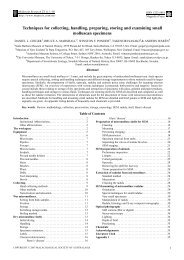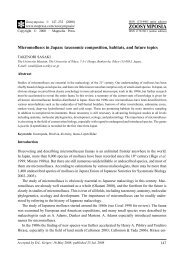Molluscs from Hydrothermal Vents and Cold Seeps in Japan: A ...
Molluscs from Hydrothermal Vents and Cold Seeps in Japan: A ...
Molluscs from Hydrothermal Vents and Cold Seeps in Japan: A ...
You also want an ePaper? Increase the reach of your titles
YUMPU automatically turns print PDFs into web optimized ePapers that Google loves.
<strong>Molluscs</strong> <strong>from</strong> <strong>Hydrothermal</strong> <strong>Vents</strong> <strong>and</strong> <strong>Cold</strong> <strong>Seeps</strong> <strong>in</strong> <strong>Japan</strong> 91material. In the list, species are arranged accord<strong>in</strong>g to published systematic arrangements (e.g.Bouchet & Rocroi, 2005 for gastropods). With<strong>in</strong> genera, species are arranged alphabetically byspecies name.For each species, the follow<strong>in</strong>g set of <strong>in</strong>formation is given. 1) Species name: The scientificname <strong>in</strong> current use is shown <strong>in</strong> bold. 2) <strong>Japan</strong>ese name: Except for undeterm<strong>in</strong>ed species, a<strong>Japan</strong>ese name is given to all species follow<strong>in</strong>g Higo et al. (1999). 3) Synonymy: Scientific namesused <strong>in</strong> the previous literature are listed with the citation of descriptions <strong>and</strong> figure numbers. 4)Type depository: <strong>in</strong>stitute <strong>and</strong> registration number of the holotype are shown with abbreviations(see below). Holotypes (or paratypes of a few species) are newly photographed <strong>and</strong> re-illustratedfor most species to facilitate reference. 5) Type locality: the name, longitude, latitude, depth,<strong>and</strong> dive numbers of the type locality are listed. 6) Distribution records: records other than thetype localities are cited <strong>from</strong> various literature. Positional data (latitude <strong>and</strong> longitude) are notdescribed for each species, but are obta<strong>in</strong>able <strong>from</strong> cited references. 7) Depth range <strong>and</strong> type ofhabitat: habitat is def<strong>in</strong>ed as vents <strong>and</strong>/or seeps.Institutional abbreviations: MNHN – Muséum national d’Histoire naturelle, Paris; NSMT –National Science Museum, Tokyo; SMF – Senckenbergisches Museum und Forschungs<strong>in</strong>stitut,Frankfurt; UMUT – The University Museum, The University of Tokyo; USNM – NationalMuseum of Natural History, Wash<strong>in</strong>gton, D. C.List of SpeciesClass POLYPLACOPHORA Gray, 1821Order Neoloricata Bergenhayn, 1955Family Leptochitonidae Dall, 1889Genus Leptochiton Gray, 18471. Leptochiton tenuidontus Saito & Okutani, 1990[<strong>Japan</strong>ese name: Usuba-samehada-hizaragai]Leptochiton tenuidontus Saito & Okutani, 1990: 166, figs. 2-12; pl. 1, figs. 1-4; Saito, 2000: 6 (pl. 3),fig. 11, 7.Type depository: Holotype, NSMT-Mo 69193.Type locality: Iheya Ridge, Ok<strong>in</strong>awa Trough, 27˚32.70´ N, 126˚58.20´ E, 1395 m (Sh<strong>in</strong>kai2000 Dive 426). Known only <strong>from</strong> the type locality.Type of habitat: Vent.Family Ischnochitonidae Dall, 1889Genus Thermochiton Saito & Okutani, 19902. Thermochiton undocostatus Saito & Okutani, 1990[<strong>Japan</strong>ese name: Yom<strong>in</strong>o-usu-hizaragai]Thermochiton undocostatus Saito & Okutani, 1990: 171, figs. 13-23; pl. 2, figs. 1-4; Saito, 2000: 11 (pl.6), 12, fig. 12.Type depository: Holotype, NSMT-Mo 69194.Type locality: Iheya Ridge, Ok<strong>in</strong>awa Trough, 27˚32.70´ N, 126˚58.20´ E, 1395 m (Sh<strong>in</strong>kai2000 Dive 426). Known only <strong>from</strong> the type locality.Type of habitat: Vent.




